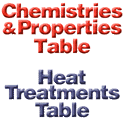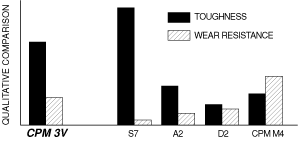
| Nominal Composition | |
| Carbon | 0.80% |
| Chromium | 7.50% |
| Vanadium | 2.75% |
| Molybdenum | 1.30% |
| Typical Applications | ||
| Stamping or Forming Tools | Punches and Dies | |
| Blanking Tools | Fineblanking Tools | |
| Industrial Knives and Slitters | Shear Blades | |
| Scrap Choppers | Rolls | |
| Plastic Injection and Extrusion Feedscrews | ||
- The wear and toughness properties of CPM 3V make it an excellent alternative to shock-resistant steels such as S7 or A9, where they typically wear out too quickly, but where grades such as A2, CruWear, or CPM M4 tend to fail by breaking or chipping. CPM 3V offers the highest impact toughness of any tool steel with this range of wear resistance.
Thermal Treatments
- Annealing
Heat to 1650°F (900°C), hold 2 hours, slow cool no faster than 25°F (15°C) per hour to 1100°F (595°C), then furnace cool or cool in still air to room temperature.
Annealed Hardness - About BHN 241
Stress-relieving
Annealed parts: Heat to 1100-1300°F (595-705°C), hold 2 hours, then furnace cool or cool in still air.
Hardened parts: Heat to 25-50°F (15-30°C) below original tempering temperature, hold 2 hours, then furnace cool or cool in still air.
Hardening
Preheat: 1450-1550F
Austenitize: 1875-2050°F (1025-1120°C), hold time (at temperature) 20-45 minutes.
Quench: Air or positive pressure quench (2 bar min) to below 125°F (50°C); or salt or interrupted oil quench to about 1000°F (540°), then air cool to below 125°F (50°C). Salt bath heat treatment will ensure maximum attainable toughness for a given hardening treatment.
Temper: Three times at 1000-1050°F (540-550°C), 2 hours minimum each time.
Size change: +0.03/0.05 %
Recommended heat treating for the best combination of toughness and wear resistance:
Austenitize 1950°F (1065°C), hold 30/45 minutes, temper 3 times at 1000°F (540°C), aim hardness 58-60 HRC. The higher austenitizing temperatures can be used to obtain higher hardness, at a slight decrease in impact resistance. The lower austenitizing temperatures provide the best impact toughness.
| Heat Treatment Response Hardness (HRC) |
||||
|
|
||||
|
|
|
|||
|
|
|
|
|
|
|
|
|
|
|
|
|
|
||||
|
|
|
|
|
|
|
|
|
|
|
|
|
|
|
|
|
|
|
|
|
|
|
|
|
|
||||

Mechanical Properties
Impact Toughness
CPM 3V offers impact toughness (Charpy C notch) approaching the shock-resistant tool steels, with much greater wear resistance.
Wear Resistance
CPM 3V offers substantial improvements in tool wear life when compared with conventional tool steels such as A2 and D2. CPM 3V’s high vanadium content offers wear resistance similar to M2 high speed steel.
| Mechanical Properties |
|||||
|
|
|||||
|
|
|
|
|||
|
|
|
|
|||
|
|
|
|
|
|
|
|
|
|||||
| CPM 3V |
|
|
|
|
|
|
CPM 3V
|
|
|
|
|
|
|
CPM 3V
|
|
|
|
|
|
|
S7
|
|
|
|
|
|
|
A2
|
|
|
|
|
|
|
D2
|
|
|
|
|
|
|
Cru-Wear
|
|
|
|
|
|
|
M2
|
|
|
|
|
|
|
CPM M4
|
|
|
|
|
|
|
|
|||||
(1) Heat treat process:
A = Hardened 1875°F (1025°C), double tempered 1000°F (540°C)
B = Hardened 1950°F (1065°C), triple tempered 1000°F (540°C)
C = Hardened 2050°F (1120°C), triple tempered 1000°F (540°C)
D = Hardened 1750°F (955°C), double tempered 400°F (205°C)
E = Hardened 1850°F (1010°C), double tempered 400°F (205°C)
F = Hardened 1950°F (1065°C), double tempered 975°F (525°C)
G = Hardened 2050°F (1120°C), double tempered 1025°F (550°C)
(2) Charpy C-notch impact test
(3) Crossed-cylinder adhesive wear resistance (higher number = better wear resistance)
Physical Properties
Modulus of Elasticity .......................................................30 psi x 106 ....................(207 GPa)
Specific gravity ...............................................................................7.7.................................(7.7)
Density .................................................................................0.280 lb/in3 ................ 7700 kg/m3
....................................................................... (7.7 g/cm3)
Thermal Conductivity .....200°F (65°C).................... 14 BTU/hr/ft/°........ 24.2 W/m°K(95C)
(95C).........................................................0.057 cal/cm-s-c
Thermal Expansion
Modulus of Elasticity .......................................................30 psi x 106 ....................(207 GPa)
Specific gravity ...............................................................................7.7.................................(7.7)
Density .................................................................................0.280 lb/in3 ................ 7700 kg/m3
....................................................................... (7.7 g/cm3)
Thermal Conductivity .....200°F (65°C).................... 14 BTU/hr/ft/°........ 24.2 W/m°K(95C)
(95C).........................................................0.057 cal/cm-s-c
Thermal Expansion
|
|
||
|
|
|
|
|
|
|
|
|
|
Machinability in the annealed condition is similar to D2 and Cru-Wear. Grindability will be similar as well. Similar grinding equipment and practices are acceptable. ‘SG’ type alumina wheels or CBN wheels have generally given the best performance with the CPM steels.
